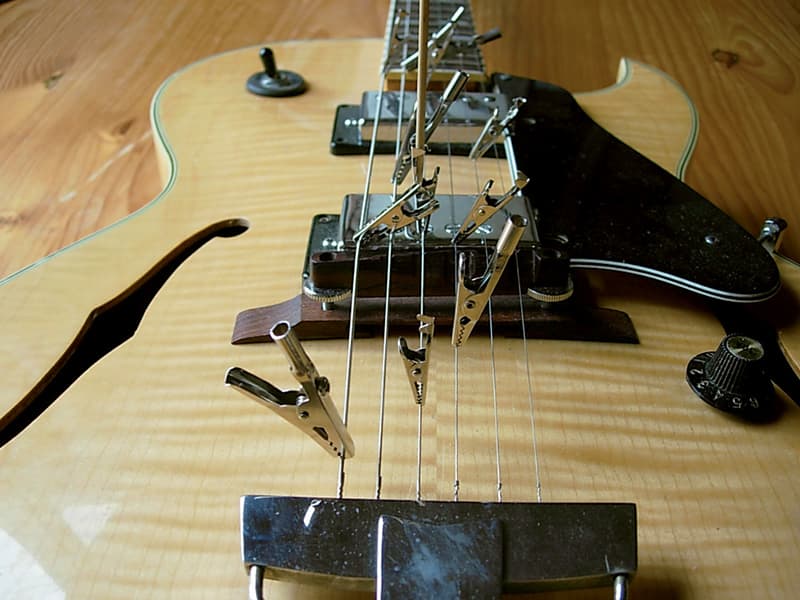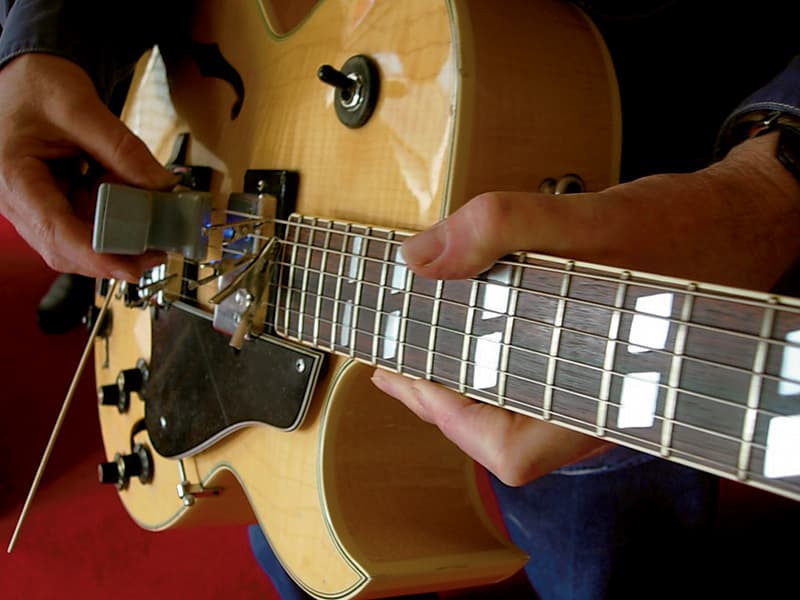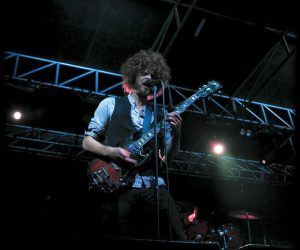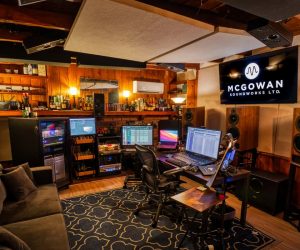
Sound for Wolf Creek
Cinema-goers worldwide have been scared witless by the unhinged antics of Mick the outback loon. Christopher Holder finds out how the sound and music played their part in rattling nerves.

It’s easy to see why Wolf Creek was funded by the South Australian Film Corporation and not the South Australian Tourism Commission. What with the Peter Falconio trial going on at the same time as Wolf Creek playing in thousands of theatres around the world, you wonder how long before Australia is subject to the sort of travel warning advice we normally reserve for places like Chechnya.
Wolf Creek also shares the same year of release as another wildly successful home-grown horror flick, Saw, but it’s a very different kettle of meathooks. I mean, how many deviously evil nutjobs are there worldwide who are currently planning to lock you in a grotty bathroom with a hacksaw? Two… three tops? But it’s much more difficult to dismiss the notion that there are psychotic fruitcakes in Australia’s very own ‘heart of darkness’ waiting to prey on the lost and desperate. It’s the authenticity of the film that’s creepy. It feels real and, by crikey, I won’t be running back for a second dose.
But I, like many others now, went running to talk to the composer of Wolf Creek’s score, François Tétaz… or Franc to his mates. Franc is probably better known to AT readers as the main man at Moose Mastering in Melbourne. But he’s no film-scoring greenhorn, having spent his younger years writing music for short films. More recently, after successfully establishing Moose and producing albums like Lior’s 3 x ARIA-nominated album Autumn Flow, Franc has hopped back into the film arena, but undoubtedly Wolf Creek is his highest profile effort yet. And what an effort it was. Franc’s music does an extraordinary job at building and maintaining the film’s realism and in many ways – as we’ll discover – it’s as authentic as the limitless outback itself.
Christopher Holder: Franc, before I ask how you went about scoring this film and contributing to the off-kilter realism of Wolf Creek… how did you actually sit through it for weeks on end? Doubtlessly you had to review footage time and time again to write the musical cues, so how did that constant exposure not tip you over the edge?!
Franc Tétaz: It’s a good question because it wasn’t easy. My wife said I was looking very grey when I came home after long days in the studio. And writing the score was a solitary experience at times. I couldn’t get anyone to watch the torture sequences when I was working on them. I was in the studio for five days doing those cues surrounded by the guts of a piano (Anthony Pateras’s decayed piano frame), a ukelyn (a mail order ukelele/violin-type instrument that you play with a bow), and pedal steel guitar I prep’d up… just looking at these images… over and over again. But it was important to determine how the drama and the shape of those sequences would unfold: where it should feel empty, where the peaks of the drama were and the moments of action were, all without overstating them… and making it feel quite odd at the same time. Any time I pulled someone in to take a look and have a listen to what I was doing, it was always the same: no, sorry, I can’t watch this. It was really hard; I couldn’t get a reaction out of anyone.
I’ve gotta concede that it’s a bit odd walking in and seeing someone working on what looks for all the world like a snuff movie. Out of context, you’re going from ‘hi, how’s your day been?’ to someone being tortured in a shed. It’s an odd place to go.

CLICHÉS GIVEN THE CHOP
CH: The film’s score bucks quite a few horror genre trends. There’s none of that heavy-breathing ‘holy moley’ music and none of that frenetic ‘run away, run away’ music And, before the final denouement, what you’ve achieved is more like sound design in some ways than a soundtrack.
FT: You’re right, there aren’t any of those clichés. The plot of the film is extremely simple – in essence it’s a harsh, action/slasher pic. But we’ve introduced European art film influences. Which all sounds like a strange combination on paper but I think it does work. It’s opened at No. 1 in the box office in Australia and went to No. 2 in the UK and a big part of the reason for that is down to it’s freshness, it’s not a slasher pic ‘by numbers’.
CH: So it must have been decided early on how the music was going to help pull that unlikely combo off?
FT: The film starts off with natural performances where you get attached to the characters. All that helps put you in their situation. When it becomes violent, it’s a case of getting the audience to ask themselves: ‘what if this was real?’. You feel like you’re there, rather than witnessing some bizarre situation that’s completely removed from reality.
The score had to reflect all that and not turn it into ‘just’ a slasher film. It had to provide emotional weight, prepare you for the film and propel you through it. So I thought of the film as a work in three parts. There’s very little score at the beginning; very nasty unsettling score in the middle; and a quite emotional, large and lush musical conclusion.
CH: Okay, where did you begin?
FT: Greg McClean [Wolf Creek’s director] and I have known each other for a few years now and creatively we’re on the same wavelength. Once I pitch him an idea he trusts me to get on with it without looking over my shoulder.
I started to look at what was going to work really well with landscapes. That was one of Greg’s main contentions; that we needed to make the landscape a character, make it something that lives.
I decided to licence some recordings from Alan Lamb, who’s a composer from WA. He owned a pocket of land with some old abandoned telegraph wires on it and in the ’80s he recorded the sound of the wires singing and straining in the wind. [Moose actually mastered and restored the recordings for Dorobo, the record label that released them in 1998.] They’ve been used before in The Boys, Kiss or Kill and others, but very much as a sound design element. I thought, ‘what about if you make them really musical in the way they worked in the landscapes?’. So I manipulated the pitch, revoiced them and layered them and actually made them into ambient pieces of score at the beginning of the film. Then I layered strings with them, as well as piano and prepared guitar and all sorts of other things.
CH: Were the telegraph recordings quite difficult to use as harmonic elements or did they toe the line?
FT: They were perfect in creating a really textured evolving sound world. Not to say the pitch didn’t creep around, but like the landscape, they had a life of their own, so they fit the bill nicely.
CH: After the road-trip beginning, our young protagonists fall foul of John Jarratt’s character in a pretty nasty fashion, and the soundtrack changes markedly.
FT: It does. It follows more of a ‘moment form’ or music concrete approach – which helps make it all quite jarring. That’s when I relied heavily on the piano frame, trying to create quite complex musical events to complement the cut and thrust, as it were, of the action on the screen. So I did all sorts of things to the piano like put screws, coins or gaffa tape on it and play the wires with mallets, forks or even a super ball. Dave Brown played a ‘prepared’ lap steel guitar – flicking alligator clips that were attached to the strings, playing it with an ebow… things like that.
CH: So was it a matter of prepping up and recording a smorgasbord of these sounds and grabbing them as desired to match the visuals?
FT: I played along to the on-screen footage as much as I could, I felt that was a better way of interpreting each particular moment. But, sure, I’d do a lot of layering and editing of material in ProTools as I honed and manipulated the sounds.
CH: And as I said earlier, the ‘music’ in the nasty section is more akin to sound design than a soundtrack, wouldn’t you say?
FT: That’s another article! How do you define the boundaries of music and sound design in a film like this? For a great deal of the film they are one and the same. That section is very loud and very gruesome. And the scale of the soundtrack totally changes. It’s meant to feel violent and jarring. I pretty much abandoned pitch and rhythm so it blurs the score and the sound design.
CH: So how did you and the sound FX/sound design people not step on each other’s toes in that section?
FT: We had sound briefings where everyone concerned would talk about their intentions and formulate a plan. So approaches like keeping the atmospheres very quiet in the middle section to ensure the audience stayed with the characters and not with the environment were all worked out well in advance. It meant there was cohesion of ideas at the end.



MIX TRICKS
Pete Smith mixed Wolf Creek. He’s a man best known for his AFI Award-winning work on Somersault and Japanese Story. Wolf Creek was mixed at Adelaide-based Best FX. The Best FX mix theatre is based around a 16-fader ProControl teamed up with an HD3 ProTools system, while Krix cinema monitoring provides the sound. Given Franc’s credentials as a bona fide audio engineer he also assisted on the mix.
FT: Moose Mastering is set up with 5.1 monitoring so I was able to do all my premixes. Best FX run ProTools like me, so I was able to put all the original files and premix stems on a drive, take it to Adelaide and plug it in. Pete then imported it all into their main session, and we were ready to roll.
CH: Did you find that your premixes translated well to the Best FX theatre?
FT: I had a few issues with the ambience of my tracks disappearing. The music is very subtle at times and I found the reverb wasn’t loud enough. That was down the fact that Moose isn’t Dolby calibrated while, naturally, Best FX is. In a Dolby room the rear speakers start rolling off from 2.5kHz and are 3dB down. So in my room I was getting plenty of ambience from my rear surrounds but at 8k the output is way down in the Dolby room, so the reverb was totally disappearing.
But fortunately I had all my original tracks so I was able to do some touch-ups in the evenings – adding more space to the strings etc. It meant that when the strings were very soft they were still very spacious instead of them being these dry things, poking out and the ambience getting lost in the sound design. It was a good example of the process working.
CH: How did the whole approach work for you Pete?
Peter Smith: It worked very well. There was sound design elements that Tom [Heuzenroeder] had laid up and Franc would either duck elements of his music that were stepping on the toes of the sound design or tailor Tom’s tracks to suit. Because we had all the elements for all the sound – FX and Franc’s music – those two aspects worked together really well; it was all automated and easy to do.
CH: Was most of the dialogue taken from on-location recordings?
PS: All of it was. There was no ADR in the whole movie. The sound recordist, Des Keneally, did a really good job, he got everything. It was shot in that hand-held doco style, and on occasions the dialogue was a bit rough and bumpy but I think it suited the style.
CH: But even though the film uses that wobbly camera style you’re stuck without a good dialogue track aren’t you? It’s got to cut through.
PS: That’s right. And I think Jason Ballantine, the editor, really helped there as well. They knew they didn’t want to do any ADR from the outset because of the budget, so during the whole editing process Jason made sure that the takes they were picking were selected for good sound as well.
CH: I guess it’s not just a budgetary decision; good sync dialogue and location recordings have to sound more authentic than ADR and the film banks on its authenticity doesn’t it?
PS: Some of what you might be alluding to is the Foley guys’ work. Des was really just supplying dialogue, he wasn’t concerned with any other location sound. The Foley guys went back out on location to get their sounds. Led by John Simpson they drove out to a quarry in the middle of the night when there wasn’t a lot of traffic. They suffered for the cause! But it does help to match the whole feel of the film, and make it sound real and not manufactured.
CH: Did you suffer for the cause? No recurring nightmares after repeated viewings of the gruesome stuff?
PS: It was horrific. Some of those scenes in the shed… it was really hard to come into work at times. I kept on having long breaks during the day when we got to that stuff. Just listening to those women scream over and over again and John Jarratt going off… it’s pretty tough. Everyone kept shutting my door. They didn’t want the rest of the building hearing ‘that bloke going off again’, scaring all the clients away! But once we got into the mix, I became a bit numb to all that side of the film.
CH: Were you promised therapy after the film?!
PS: No, but Greg [McClean] promised us a romantic comedy next… But it’s not. It’s a rogue crocodile!

















RESPONSES